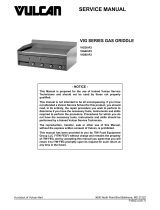
-
2 -
TABLE OF CONTENTS
INSTALLATION…………………………………………………………..
OPERATION……………………………………………………………...
CLEANING………………………………………………………………..
LUBRICATION……………………………………………………………
SPECIFICATIONS……………………………………………………….
COMPONENT LOCATION……………………………………………...
CONTROL PANEL……………………………………………………….
BULLNOSE……………………………………………………………….
BACK PANEL…………………………………………………………….
IDENTIFICATION PLATE……………………………………………….
FLUE……………………………………………………………………….
THERMOSTAT…………………………………………………………...
THERMOSTAT TROUBLESHOOTING.............................................
SYMPTON-BURNER WILL NOT COME ON………………………….
SYMPTON-GRIDDLE SURFACE TEMPERATURE IS MORE
THAN 5° F OFF THERMOSTAT SETPOINT………………………….
THERMOSTAT REMOVAL……………………………………………...
TEMPERATURE PROBE……………………………………………….
TEMPERATURE PROBE REMOVAL………………………………….
TEMPERATURE PROBE INSTALLATION……………………………
ADJUSTMENTS………………………………………………………….
CALIBRATION……………………………………………………………
POWER ON/OFF SWITCH……………………………………………...
POWER SWITCH TROUBLESHOOTING……………………………..
SYMPTON-NO POWER SUPPLIED TO UNIT………………………..
POWER SWITCH REMOVAL AND INSTALLATION………………...
INDICATOR LIGHT………………………………………………………
INDICATOR LIGHT TROUBLESHOOTING…...................................
SYMPTON-LIGHT DOES NOT COME ON WHEN THERMOSTAT
AND BURNER ARE ON…………………………………………………
INDICATOR LIGHT REMOVAL…………………………………………
SAFETY IGNITION MODULE…………………………………………..
SAFETY IGNITION MODULE TROUBLESHOOTING……………….
SYMPTON-NO SPARK BETWEEN PILOT HEAD AND
ELECTRODE……………………………………………………………..
SYMPTON-ELECTRODE CONTINUALLY SPARKS AFTER PILOT
IS LIT………………………………………………………………………
SYMPTON-BURNER SOLENOID VALVE OPENS WITHOUT
ESTABLISHED PILOT FLAME…………………………………………
SAFETY IGNITION MODULE REMOVAL…………………………….
SOLENOID VALVES…………………………………………………….
SOLENOID VALVE TROUBLESHOOTING…………………………...
SYMPTON-NO GAS FLOW TO BURNER…………………………….
SOLENOID VALVE REMOVAL…………………………………………
PILOT……………………………………………………………………...
PILOT TROUBLESHOOTING…………………………………………..
SYMPTON-PILOT WILL NOT LIGHT………………………………….
PILOT ASSEMBLY REMOVAL…………………………………………
4
4
4
4
4
5
6
6
6
6
6
7
7
7
7
8
8
8
8
9
9
10
10
10
10
11
11
11
11
11
12
12
12
12
12
12
13
13
13
14
14
14
14




















